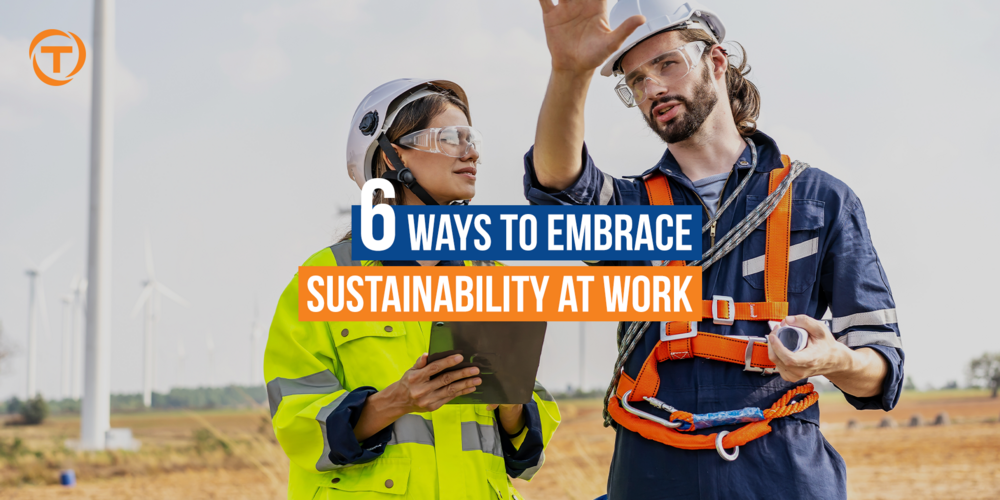With a growing global appetite for sustainability, Australian business leaders agree that positive, effective action is key to addressing rising environmental concerns. And if you’re reading this, you likely form part of the 75% of organisations very concerned about climate change (Deloitte CxO Sustainability Report, 2022).
When you want to honour your corporate responsibility and join the evolving sustainability revolution, there are powerful policies, programs, and practices you can put into place that will help lower your organisation’s environmental impact, be it on site or for your remote workers.
So, why go green?
The benefits of a sustainable workplace are plentiful. Not only will it make a positive environmental impact, it can also help engage and retain your employees, win over your customers, and add value to your bottom line. If you’re still not sold on sustainability, here are some valuable reasons why it’s time to act.
Customer Loyalty
Becoming more sustainable is a sure-fire way to increase customer loyalty. A BBC survey reported that 81% of consumers agree that demonstrating a commitment to sustainability adds value to a brand. Even better, 73% are happy to pay more for brands with strong sustainability and eco-friendly practices.
Employee retention
Emerging research shows that firms with a strong commitment to environmental, social, and corporate governance (ESG) are more likely to retain employees – and this leads to increased growth. A Bain & Company study of 100,000 businesses revealed a positive correlation between ESG and profitability and that businesses with the most satisfied employees had three-year revenue growth up to 6% above those in their sectors with the least satisfied employees.
The key to implementation
For workplace sustainability to be a part of company culture and workplace values, token gestures won’t do the job. Rather, a holistic approach with thoughtful planning and strategic implementation is the way to go. To get you inspired, these six workplace sustainability tips can help your business preserve resources and lower its carbon footprint while giving it that all-important competitive edge.
1 Generate awareness and advocacy through training and initiatives
Creating excitement amongst staff and stakeholders about sustainability at work is an ideal first step for fostering a culture of environmental responsibility. You don’t just want them to go along with green policies, you want them to be fully paid-up cheerleaders who are motivated to make a difference.
The good news: they’re ready to.
A recent CONE study revealed that 83% of millennials would be more loyal to a company that helps them contribute to social and environmental issues.
To get employees educated (and on-side), consider organising training sessions and workshops focused on sustainability topics. These could include building eco-friendly office habits, helpful energy-saving techniques, waste reduction tips and recycling policies. If you have a team of employees that work from home, you can help remote workers adopt the same principles but with modifications that align with working from home needs. Think; saving energy by switching off equipment and appliances or using as much natural light as possible.
Inviting experts or keynote speakers to provide insights on sustainable practices relevant to your industry will lend credibility to your organisation’s efforts. You won’t want to overlook reward and recognition, either. Try incentivising eco-friendly practices like carpooling or walking to work or launching a bike-to-work scheme.
2 Consider becoming sustainably certified
Your business can obtain a sustainable stamp of approval through certification as a sustainable organisation. There are national and international bodies that provide certifications to businesses meeting rigorous environmental standards.
Climate Active, a partnership between the Australian Government and Australian businesses, identifies organisations that go above and beyond to achieve carbon neutrality, making them the gold standard of sustainability. Being Climate Active-certified signals your commitment to reducing emissions to clients, customers, and employees.
EcoVadis is another choice that has grown to become the world’s largest and most trusted provider of business sustainability ratings, creating a global network of more than 100,000+ rated companies. Sustainability analysts assess your organisation's practices and generate a report on environmental, social, and ethical risks. Achieving a high EcoVadis rating demonstrates your commitment to sustainability, opening doors to collaboration with other certified sustainable companies and strengthening risk management strategies.
3 Do sustainable swaps for office supplies
Switching to eco-friendly office supplies and sundries isn’t just kinder to the environment, it’ll save money too. Take stock of all your office supplies (and suppliers) to establish what you can swap. In terms of paper products like notebooks and copy paper, choose 100% recycled or FSC-certified.
If you want to go one-step further to reduce the amount of paper used by using electronic files, cloud storage and collaborative online platforms for sharing and editing documents. Lockheed Martin and General Electric estimated savings of between $250,000 to $10 billion USD simply by digitising paper manuals and processes that used to require paper.
For those brainstorming sessions, replace disposable paper flip charts and sticky notes with reusable dry-erase boards and markers to jot down notes and reminders. In terms of break room disposable utensils, swap plastic for compostable or biodegradable cups, cutlery and plates made from materials like bamboo, sugarcane or corn starch. Cleaning chemicals can be bad for the environment too, so switch to a supplier that provides eco-friendly, natural alternatives.
4 Implement water conservation initiatives
For the driest continent on Earth, Australia has one of the biggest water footprints in the world, consuming 1,156 gallons per person, daily. Reducing water waste is an important step for businesses and can make a huge difference.
Start by conducting a water audit to assess your organisation’s water consumption patterns and identify areas of waste. Inspect and repair leaks and any dripping taps throughout your building. Got age-old plumbing? Consider replacing inefficient fixtures with water-saving alternatives like low-flow aerators in faucets, timer taps and showerheads.
If possible, look for opportunities to capture and store rainfall. Installing rainwater tanks may be able to provide a supply for outdoor cleaning, toilet flushing or garden irrigation. To really maximise water savings, a smart irrigation system that uses weather data and soil moisture sensors can schedule irrigation during the early morning or late evening to prevent evaporation loss.
5 Become more energy-efficient
Positively, Australian industrial energy use is lowering, with a 4.3% decrease in the year 20-21, and your business can be part of the continual change by both conserving energy and becoming more energy efficient.
You can start by researching the grants, funding and incentives that may be available for your workplace. There may be financial help available at an Australian Government or state and territory government level to help your business become more energy efficient.
Small steps towards energy efficiency can make a meaningful difference over time. Check your energy to see if they support 100% renewable energy. Optimising your building’s heating, ventilation and air conditioning systems for energy efficiency can be a great way to boost your sustainability and cut costs over time. Ensure your systems are maintained, replacing filters when required to guarantee optimal performance.
When workplace equipment, appliances and machinery approach the end of life, upgrade to energy efficient alternatives with a high star Energy Rating Label. Likewise, with lighting. If your organisation’s lighting is outdated, LEDs use 75% less energy than traditional halogen bulbs, so investigate upgrading.
Want to save even more energy on site? Allow employees to work from home where possible. According to Global Workplace Analytics, IBM cut down real estate costs by $50 million USD.
6 Finding inspiration from other sustainable Australian businesses
When it comes to environmental trailblazers, Winner of the Sustainable Distillery of the Year in the World Whisky Awards, Lark Distillery, is one to look out for.
Lark Distillery received Climate Active certification by making widespread changes in multiple areas of the business. It purchased 1,500 tonnes of carbon credits, reduced the size of its outer packaging by 30% and switched to its energy supplier’s ‘green gas’ option. Lark Distillery’s actions really underscore the 360 approach necessary to achieve carbon neutrality.
Another business to look toward is Hub Australia, a certified B Corporation that offers sustainable and eco-friendly workspaces nationwide. Through its impact-focused initiatives, Hub Australia became Australia's first carbon neutral certified coworking provider in 2020. From small wins like recycling bins, eco-friendly cleaning products and CO2-absorbing plants, to larger strategies like offsetting all carbon output on behalf of staff and members, Hub Australia’s commitment to sustainability is inspirational.
Summary
• 75% of Australian business leaders say their organisation is very concerned about climate change.
• Aside from supporting the environment, a business that embraces sustainability will engage and retain employees, attract new and existing customers and nurture growth.
• Holding team training sessions and creating environmentally initiatives is a great way to build employee awareness and advocacy when it comes to sustainability.
• Consider becoming certified through Climate Active and obtaining your sustainability rating from a trusted provider such as EcoVadis.
• Reduce reliance on paper as much as possible by using digital files and choose 100% recycled or FSC-certified paper products. Swap plastics for biodegradable alternatives and choose eco-friendly cleaning products.
• Implement water-conserving initiatives such as capturing rainfall, upgrading to slow-flow faucets and swiftly fixing leaks.
• Investigate energy efficiency grants, swap to a provider that suppliers 100% renewable energy, upgrade to appliances and equipment with a high star Energy Rating Label and choose LED lighting.
• Take inspiration from the steps Climate Active certified Australian organisations have taken to become carbon neutral.
If you are open to new opportunities, contact a recruitment agency like Trojan Recruitment Group and receive advice from the experts in labour-hire, permanent and contract staff.
Sources
https://www.edie.net/more-sustainable-business-is-more-profitable-business-study-finds/
https://www.climateactive.org.au/
https://sustainability.tufts.edu/wp-content/uploads/BusinessGuidetoPaperReduction.pdf
https://www.latimes.com/business/story/2019-09-20/how-businesses-profit-from-environmentalism
https://www.abs.gov.au/statistics/industry/energy/energy-account-australia/2020-21
https://www.matthews.com.au/blog/9-sustainable-australian-companies-to-learn-from
https://business.gov.au/environmental-management/manage-energy-use
https://larkdistillery.com/pages/carbon-neutrality
https://www.hubaustralia.com/impact/
https://www.energy.gov.au/business/grants-and-funding
https://globalworkplaceanalytics.com/resources/costs-benefits


